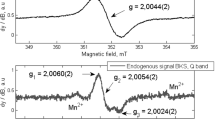Abstract
The most significant problem of electron paramagnetic resonance (EPR) fingernail dosimetry is the presence of two signals of non-radiation origin that overlap the radiation-induced signal (RIS), making it almost impossible to perform dose measurements below 5 Gy. Historically, these two non-radiation components were named mechanically induced signal (MIS) and background signal (BKS). In order to investigate them in detail, three different methods of MIS and BKS mutual isolation have been developed and implemented. After applying these methods, it is shown here that fingernail tissue, after cut, can be modeled as a deformed sponge, where the MIS and BKS are associated with the stress from elastic and plastic deformations, respectively. A sponge has a unique mechanism of mechanical stress absorption, which is necessary for fingernails in order to perform its everyday function of protecting the fingertips from hits and trauma. Like a sponge, fingernails are also known to be an effective water absorber. When a sponge is saturated with water, it tends to restore to its original shape, and when it loses water, it becomes deformed again. The same happens to fingernail tissue. It is proposed that the MIS and BKS signals of mechanical origin be named MIS1 and MIS2 for MISs 1 and 2, respectively. Our suggested interpretation of the mechanical deformation in fingernails gives also a way to distinguish between the MIS and RIS. The results obtained show that the MIS in irradiated fingernails can be almost completely eliminated without a significant change to the RIS by soaking the sample for 10 min in water. The proposed method to measure porosity (the fraction of void space in spongy material) of the fingernails gave values of 0.46–0.48 for three of the studied samples. Existing results of fingernail dosimetry have been obtained on mechanically stressed samples and are not related to the “real” in vivo dosimetric properties of fingernails. A preliminary study of these properties of pre-soaked (unstressed) fingernails has demonstrated their significant difference from fingernails stressed by cut. They show a higher stability signal, a less intensive non-radiation component, and a nonlinear dose dependence. The findings in this study set the stage for understanding fingernail EPR dosimetry and doing in vivo measurements in the future.
















Similar content being viewed by others
References
Symons MC, Chandra H, Wyatt JL (1995) Electron paramagnetic resonance spectra of irradiated finger-nails: a possible measure of accidental exposure. Radiat Prot Dosim 58:11–15
Dalgarno BG, McClymont JD (1989) Evaluation of ESR as a radiation accident dosimetry technique. Appl Radiat Isot 40:1013–1020
Romanyukha A, Trompier F, LeBlanc B, Calas C, Clairand I, Mitchell CA, Smirniotopoulos JG, Swartz HM (2007) EPR dosimetry in chemically treated fingernails. Radiat Meas 42:1110–1113
Trompier F, Kornak L, Calas C, Romanyukha A, LeBlanc B, Clairand I, Mitchell CA, Swartz HM (2007) Protocol for emergency EPR dosimetry in fingernails. Radiat Meas 42:1085–1088
Chandra H, Symons MC (1987) Sulphur radicals formed by cutting alpha-keratin. Nature 328:833–834
Ignatiev EA, Romanyukha AA, Koshta AA, Wieser A (1996) Selective saturation method for EPR dosimetry with tooth enamel. Appl Radiat Isot 47:333–337
Finlay AY, Frost P, Keith AD, Snipes W (1980) An assessment of factors influencing flexibility of human fingernails. Br J Dermatol 103:357–365
Swartz HM, Iwasaki A, Walczak T, Demidenko E, Salikhov I, Khan N, Lesniewski P, Thomas JA, Romanyukha A, Schauer DA, Starewicz P (2006) In vivo EPR dosimetry to quantify exposures to clinically significant doses of ionising radiation. Radiat Prot Dosim 120:163–170
Zdravkova M, Crokart N, Trompier F, Beghein N, Gallez B, Debuyst R (2004) Non-invasive determination of the irradiation dose in fingers using low-frequency EPR. Phys Med Biol 49:2891–2898
Farren L, Shayler S, Ennos AR (2004) The fracture properties and mechanical design of human fingernails. J Exp Biol 207:735–741
Egawa M, Ozaki Y, Takahashi M (2006) In vivo measurement of water content of the fingernail and its seasonal change. Skin Res Technol 12:126–132
Mason P (1963) Density and structure of alpha-keratin. Nature 197:179–180
Romanyukha A, Trompier F, Swartz HM (2007) EPR dosimetry with fingernails. US Patent Provisional No. 60/924,034, USA
Stern DK, Diamantis S, Smith E, Wei H, Gordon M, Muigai W, Moshier E, Lebwohl M, Spuls P (2007) Water content and other aspects of brittle versus normal fingernails. J Am Acad Dermatol 57:31–36
Author information
Authors and Affiliations
Corresponding author
Rights and permissions
About this article
Cite this article
Reyes, R.A., Romanyukha, A., Trompier, F. et al. Electron paramagnetic resonance in human fingernails: the sponge model implication. Radiat Environ Biophys 47, 515–526 (2008). https://doi.org/10.1007/s00411-008-0178-8
Received:
Accepted:
Published:
Issue Date:
DOI: https://doi.org/10.1007/s00411-008-0178-8




